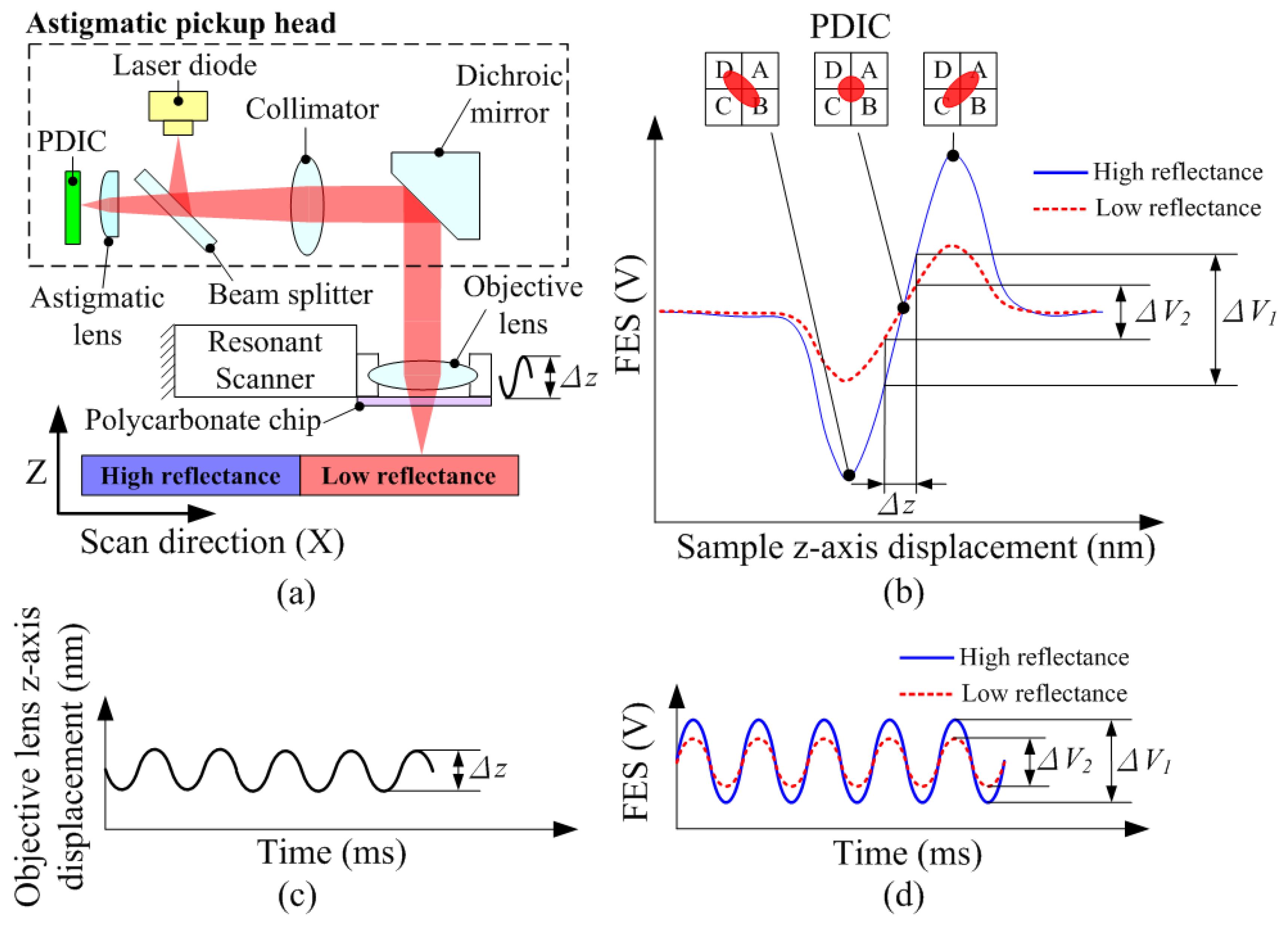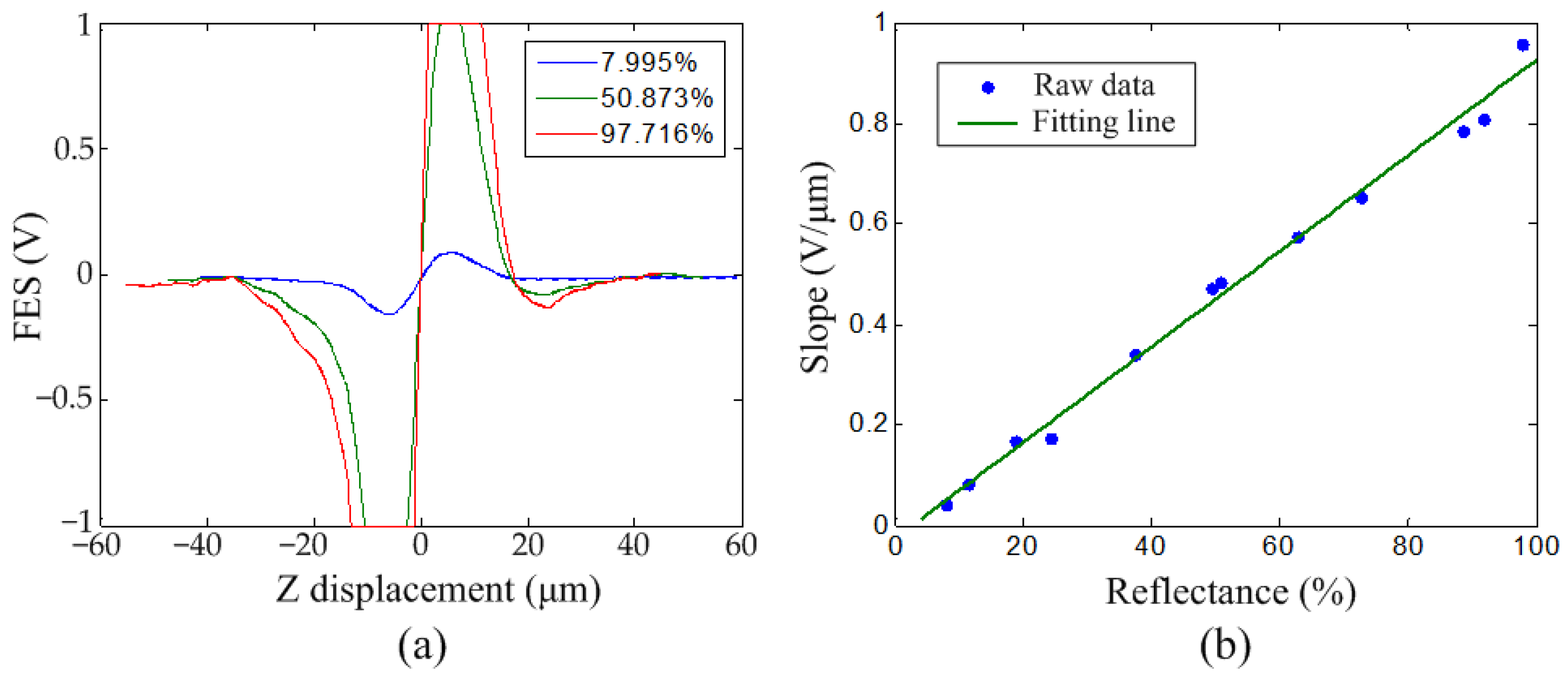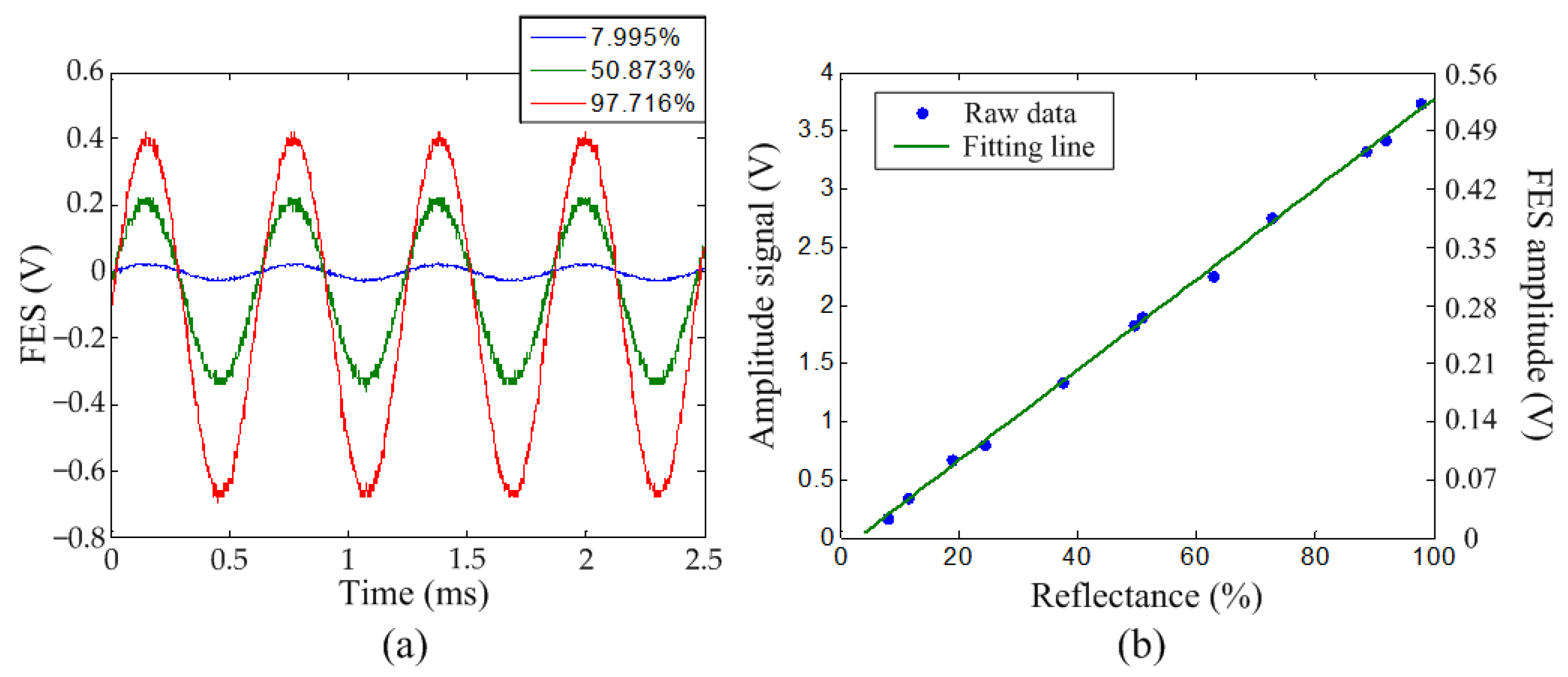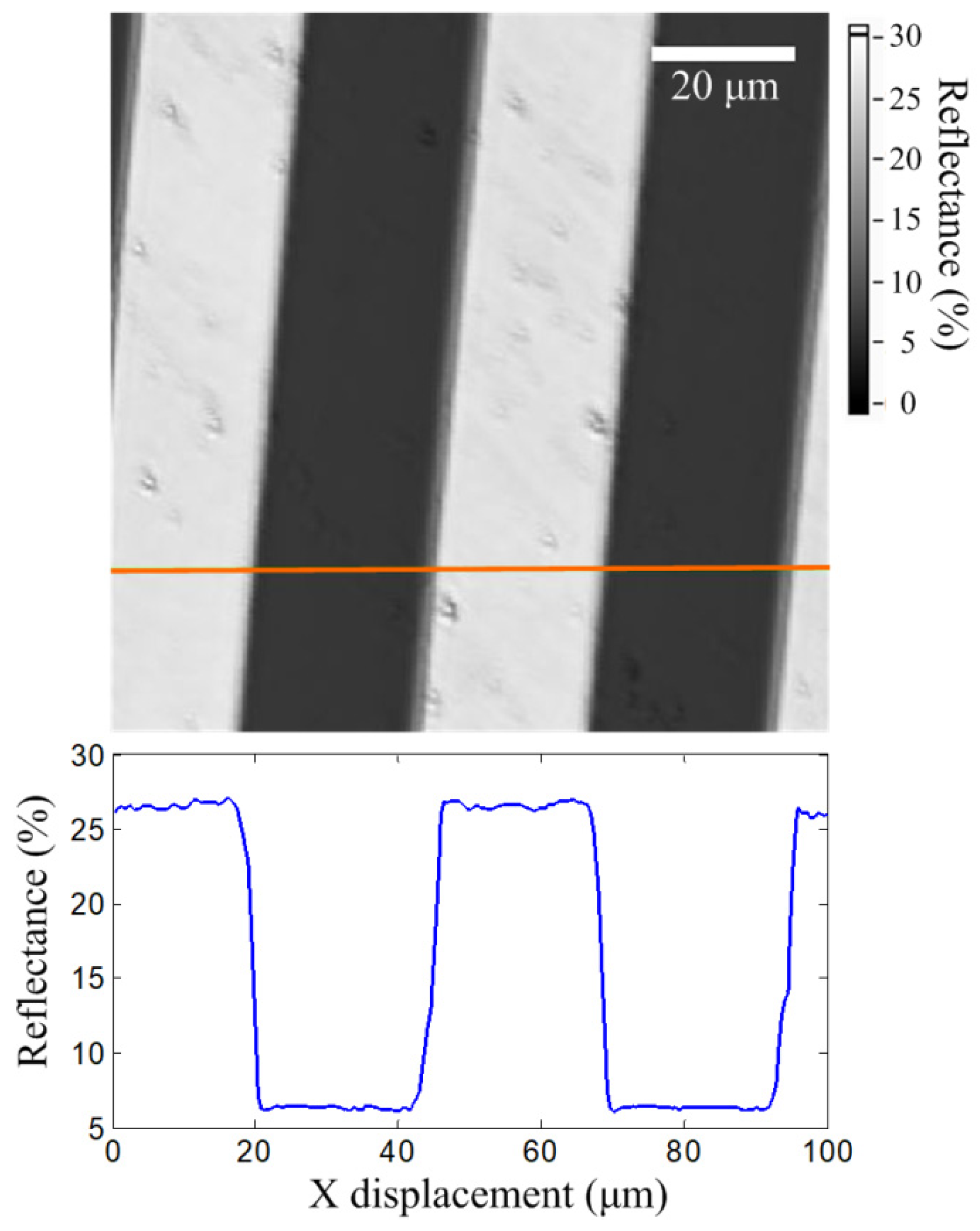Real-Time Reflectance Measurement Using an Astigmatic Optical Profilometer
Abstract
1. Introduction
2. Materials and Methods
2.1. Method of Real-Time Reflectance Measurement
2.2. Astigmatic Optical Profilometer
3. Results and Discussion
3.1. S-Curve Slope vs. Reflectance
3.2. Amplitude Signal vs. Reflectance
3.3. Real-Time Reflectance Imaging
4. Conclusions
Author Contributions
Funding
Informed Consent Statement
Data Availability Statement
Conflicts of Interest
References
- Dijt, J.C.; Stuart, M.A.C.; Fleer, G.J. Reflectometry as a tool for adsorption studies. Adv. Colloid Interface Sci. 1994, 50, 79–101. [Google Scholar] [CrossRef]
- Wedowski, M.; Underwood, J.H.; Gullikson, E.M.; Bajt, S.; James, A.; Folta, J.A.; Kearney, P.A.; Montcalm, C.; Spiller, E. High-Precision Reflectometry of Multilayer Coatings for Extreme Ultraviolet Lithography. In Proceedings of the SPIE, Santa Clara, CA, USA, 21 July 2000; Volume 3997, pp. 83–93. [Google Scholar]
- Arends, A.A.; Germain, T.M.; Owens, J.F.; Putnam, S.A. Simultaneous reflectometry and interferometry for measuring thin-film thickness and curvature. Rev. Sci. Instrum. 2018, 89, 055117. [Google Scholar] [CrossRef] [PubMed]
- Akter, S.; Hossain, M.G.; Nishidate, I.; Hazama, H.; Awazu, K. Medical applications of reflectance spectroscopy in the diffusive and sub-diffusive regimes. J. Near Infrared Spectrosc. 2018, 26, 337–350. [Google Scholar] [CrossRef]
- Seifter, A.; Boboridis, K.; Obst, A.W. Emissivity Measurements on Metallic Surfaces with Various Degrees of Roughness: A Comparison of Laser Polarimetry and Integrating Sphere Reflectometry. Int. J. Thermophys. 2004, 25, 547–560. [Google Scholar] [CrossRef]
- Oksman, A.; Kuivalainen, K.; Tag, C.-M.; Juuti, M.; Mattila, R.; Hietala, E.; Gane, P.A.C.; Peiponen, K.-E. Diffractive optical element–based glossmeter for the on-line measurement of normal reflectance on a printed porous coated paper. Opt. Eng. 2011, 50, 043606. [Google Scholar] [CrossRef]
- Andor, G. Gonioreflectometer-based gloss standard calibration. Metrologia 2003, 40, S97–S100. [Google Scholar] [CrossRef]
- Gene, J.; Jeon, M.Y.; Lim, S.D. Reflectometers for Absolute and Relative Reflectance Measurements in the Mid-IR Region at Vacuum. Sensors 2021, 21, 1169. [Google Scholar] [CrossRef]
- Elton, N.J.; Day, J.C.C. A reflectometer for the combined measurement of refractive index, microroughness, macroroughness and gloss of low-extinction surfaces. Meas. Sci. Technol. 2009, 20, 025309. [Google Scholar] [CrossRef]
- Kang, M.-S.; Joo, S.-J.; Bahng, W.; Lee, J.-H.; Kim, N.-K.; Koo, S.-M. Anti-reflective nano- and micro-structures on 4H-SiC for photodiodes. Nanoscale Res. Lett. 2011, 6, 236. [Google Scholar] [CrossRef]
- Tan, X.; Tao, Z.; Yu, M.; Wu, H.; Li, H. Anti-reflectance investigation of a micro-nano hybrid structure fabricated by dry/wet etching methods. Sci. Rep. 2018, 8, 7863. [Google Scholar] [CrossRef]
- Fernández-García, A.; Sutter, F.; Martínez-Arcos, L.; Sansom, C.; Wolfertstetter, F.; Delord, C. Equipment and methods for measuring reflectance of concentrating solar reflector materials. Sol. Energy Mater. Sol. Cells 2017, 167, 28–52. [Google Scholar] [CrossRef]
- Baron, E.L.; Grosjean, A.; Bourdon, D.; Pescheux, A.-C.; Vidal, F.; Disdier, A. New equipment for measurement of soiling and specular reflectance on solar mirrors. In Proceedings of the AIP Conference Proceedings, Daegu, Korea, 11 December 2020; Volume 2303, p. 150011. [Google Scholar]
- Ehrmann, K.; Ho, A.; Schindhelm, K. A 3D optical profilometer using a compact disc reading head. Meas. Sci. Technol. 1998, 9, 1259–1265. [Google Scholar] [CrossRef]
- Hwu, E.T.; Hung, S.K.; Yang, C.W.; Huang, K.Y.; Hwang, I.S. Real-time detection of linear and angular displacements with a modified DVD optical head. Nanotechnology 2008, 19, 115501. [Google Scholar] [CrossRef] [PubMed]
- Hwu, E.T.; Illers, H.; Jusko, L.; Danzebrink, H.U. A hybrid scanning probe microscope (SPM) module based on a DVD optical head. Meas. Sci. Technol. 2009, 20, 084005. [Google Scholar] [CrossRef]
- Hwu, E.E.-T.; Boisen, A. Hacking CD/DVD/Blu-ray for Biosensing. ACS Sens. 2018, 3, 1222–1232. [Google Scholar] [CrossRef] [PubMed]
- Bosco, F.G.; Hwu, E.T.; Chen, C.H.; Keller, S.; Bache, M.; Jakobsen, M.H.; Hwang, I.S.; Boisen, A. High throughput label-free platform for statistical bio-molecular sensing. Lab Chip 2011, 11, 2411–2416. [Google Scholar] [CrossRef]
- Li, X.Z.; Kim, S.; Cho, W.; Lee, S.Y. Optical detection of nanoparticle-enhanced human papillomavirus genotyping microarrays. Biomed.Opt. Express 2013, 4, 187–192. [Google Scholar] [CrossRef]
- Hsiao, W.W.; Liao, H.S.; Lin, H.H.; Lee, Y.L.; Fan, C.K.; Liao, C.W.; Lin, P.Y.; Hwu, E.T.; Chang, C.S. Biophysical analysis of astrocytes apoptosis triggered by larval E/S antigen from cerebral toxocarosis-causing pathogen Toxocara canis. Anal. Sci. 2013, 29, 885–892. [Google Scholar] [CrossRef][Green Version]
- Liao, H.S.; Cheng, S.H.; Hwu, E.T. Method for Film Thickness Mapping with an Astigmatic Optical Profilometer. Sensors 2022, 22, 2865. [Google Scholar] [CrossRef]
- Liao, H.-S.; Huang, G.-T.; Tu, H.-D.; Lin, T.-H.; Hwu, E.-T. A novel method for quantitative height measurement based on an astigmatic optical profilometer. Meas. Sci. Technol. 2018, 29, 107002. [Google Scholar] [CrossRef]
- Liao, H.-S.; Cheng, S.-H.; Hwu, E.-T. Development of a Resonant Scanner to Improve the Imaging Rate of Astigmatic Optical Profilometers. IEEE/ASME T. Mech. 2021, 26, 1172–1177. [Google Scholar] [CrossRef]
- Liao, H.S.; Huang, K.Y.; Hwang, I.S.; Chang, T.J.; Hsiao, W.W.; Lin, H.H.; Hwu, E.T.; Chang, C.S. Operation of astigmatic-detection atomic force microscopy in liquid environments. Rev. Sci. Instrum. 2013, 84, 103709. [Google Scholar] [CrossRef] [PubMed]
- Wang, W.M.; Cheng, C.H.; Molnar, G.; Hwang, I.S.; Huang, K.Y.; Danzebrink, H.U.; Hwu, E.T. Optical imaging module for astigmatic detection system. Rev. Sci. Instrum. 2016, 87, 053706. [Google Scholar] [CrossRef] [PubMed]





| Product Number | Reflectance (%) | Slope (V/μm) | Amplitude Signal (V) | FES Amplitude (V) |
|---|---|---|---|---|
| A3380020-4 | 7.995 | 0.0433 | 0.172 | 0.0241 |
| A3380020-1 | 11.455 | 0.0847 | 0.345 | 0.0483 |
| A3380020-2 | 18.714 | 0.1667 | 0.674 | 0.0944 |
| A3380018-5 | 24.403 | 0.1751 | 0.805 | 0.1127 |
| A3380020-5 | 37.510 | 0.3411 | 1.339 | 0.1875 |
| A3380020-3 | 49.478 | 0.4735 | 1.836 | 0.2570 |
| A3380018-010 | 50.873 | 0.4852 | 1.901 | 0.2661 |
| A3380018-011 | 62.771 | 0.5738 | 2.256 | 0.3158 |
| A3380018-3 | 72.776 | 0.6538 | 2.753 | 0.3854 |
| A3380018-7 | 88.695 | 0.7861 | 3.323 | 0.4652 |
| A3380018-8 | 91.922 | 0.8089 | 3.422 | 0.4791 |
| A3380021-4 | 97.716 | 0.9578 | 3.740 | 0.5228 |
Publisher’s Note: MDPI stays neutral with regard to jurisdictional claims in published maps and institutional affiliations. |
© 2022 by the authors. Licensee MDPI, Basel, Switzerland. This article is an open access article distributed under the terms and conditions of the Creative Commons Attribution (CC BY) license (https://creativecommons.org/licenses/by/4.0/).
Share and Cite
Liao, H.-S.; Huang, Y.-K.; Syu-Gu, J.-Y.; Hwu, E.-T. Real-Time Reflectance Measurement Using an Astigmatic Optical Profilometer. Sensors 2022, 22, 6242. https://doi.org/10.3390/s22166242
Liao H-S, Huang Y-K, Syu-Gu J-Y, Hwu E-T. Real-Time Reflectance Measurement Using an Astigmatic Optical Profilometer. Sensors. 2022; 22(16):6242. https://doi.org/10.3390/s22166242
Chicago/Turabian StyleLiao, Hsien-Shun, Ya-Kang Huang, Jian-Yuan Syu-Gu, and En-Te Hwu. 2022. "Real-Time Reflectance Measurement Using an Astigmatic Optical Profilometer" Sensors 22, no. 16: 6242. https://doi.org/10.3390/s22166242
APA StyleLiao, H.-S., Huang, Y.-K., Syu-Gu, J.-Y., & Hwu, E.-T. (2022). Real-Time Reflectance Measurement Using an Astigmatic Optical Profilometer. Sensors, 22(16), 6242. https://doi.org/10.3390/s22166242






